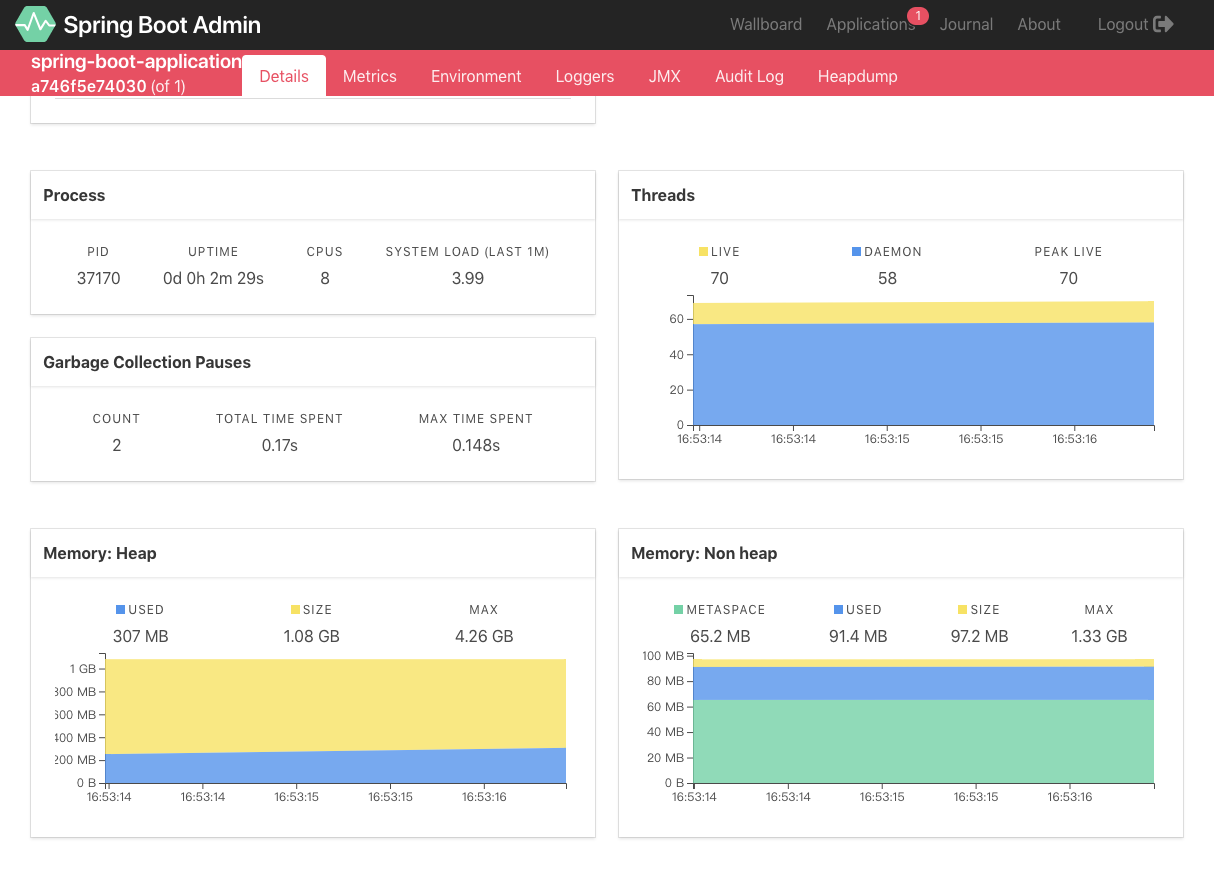在上一篇中,通过restful api的方式查看信息过于繁琐,也不直观,效率低下。当服务过多的时候看起来就过于麻烦,每个服务都需要调用不同的接口来查看监控信息。
SBA
SBA全称spring boot admin 是一个管理和监控spring boot 应用程序的开源项目,分为admin-server与admin-client两个组件,admin-server通过采集actuator端点数据,显示在spring -boot-admin-ui上,已知的端点几乎都有进行采集,通过spring-boot-admin可以动态切换日志级别、导出日志、导出heapdump、监控各项指标 等等
spring boot admin在对单一服务监控的同时也提供了集群监控方案,支持通过eureka、consul、zookeeper等注册中心的方式实现多服务监控与管理
导入依赖
在pom.xml中添加对spring-boot-admin的相关依赖
<!-- 服务端:带UI界面 -->
<dependency>
<groupId>de.codecentric</groupId>
<artifactId>spring-boot-admin-starter-server</artifactId>
<version>2.0.0</version>
</dependency>
<!-- 客户端包 -->
<dependency>
<groupId>de.codecentric</groupId>
<artifactId>spring-boot-admin-starter-client</artifactId>
<version>2.0.0</version>
</dependency>
<!-- 安全认证 -->
<dependency>
<groupId>org.springframework.boot</groupId>
<artifactId>spring-boot-starter-security</artifactId>
</dependency>
<!-- 端点 -->
<dependency>
<groupId>org.springframework.boot</groupId>
<artifactId>spring-boot-starter-actuator</artifactId>
</dependency>
<!-- 在管理界面中与 JMX-beans 进行交互所需要被依赖的 JAR -->
<dependency>
<groupId>org.jolokia</groupId>
<artifactId>jolokia-core</artifactId>
</dependency>
如果想访问info的信息需要如下配置
<build>
<plugins>
<plugin>
<groupId>org.springframework.boot</groupId>
<artifactId>spring-boot-maven-plugin</artifactId>
<executions>
<execution>
<goals>
<goal>build-info</goal>
</goals>
</execution>
</executions>
</plugin>
</plugins>
</build>
属性配置
在application.yml中配置actuator的相关配置,其中info开头的属性,就是访问info端点中显示的相关内容,值得注意的十spring boot2.x中,默认只开放了info、health两个端点,剩余的需要自己通过配置management.endpoints.web.exposure.include属性来加载,这个management.endpoints.web.base-path属性比较重要,因为spring boot2.x后每个端点默认的路径是/actuator/endpointId这样依赖spring boot admin是无法正常采集的
application.yml
spring: profiles: active: prod #指定读取哪个文件 boot: admin: client: url: http://localhost:8088 instance: prefer-ip: true info: head: head body: body management: endpoints: web: exposure: #加载所有的端点,默认只加载了info、health include: '*' #不配置SBA 扫描不到 base-path: / endpoint: health: show-details: always #可以关闭指定的端点 shutdown: enabled: false
application-dev.yml 空的
application-prod.yml
server: port: 8088 servlet: context-path: / spring: boot: admin: client: username: david password: 123456 instance: metadata: user: name: david password: 123456 security: user: name: david password: 123456
在启动方法中增加@EnableAdminServer注解 代表是Server端
@EnableAdminServer @SpringBootApplication public class BootApplication{ public static void main(String[] args) { SpringApplication.run(BootApplication.class,args); } @Profile("dev") @Configuration public static class SecurityPermitAllConfig extends WebSecurityConfigurerAdapter{ @Override protected void configure(HttpSecurity http) throws Exception{ http.authorizeRequests().anyRequest().permitAll().and().csrf().disable(); } } @Profile("prod") @Configuration public static class SecuritySecureConfig extends WebSecurityConfigurerAdapter{ private final String adminContextPath; public SecuritySecureConfig(AdminServerProperties adminServerProperties){ this.adminContextPath = adminServerProperties.getContextPath(); } @Override protected void configure(HttpSecurity http) throws Exception{ SavedRequestAwareAuthenticationSuccessHandler successHandler = new SavedRequestAwareAuthenticationSuccessHandler(); successHandler.setTargetUrlParameter("redirectTo"); http.authorizeRequests() .antMatchers(adminContextPath + "/assets/**").permitAll() .antMatchers(adminContextPath + "/login").permitAll() .anyRequest().authenticated() .and() .formLogin().loginPage(adminContextPath + "/login").successHandler(successHandler).and() .logout().logoutUrl(adminContextPath + "/logout").and() .httpBasic().and() .csrf().disable(); } } }
测试
启动项目 访问 http://localhost:8088/login
